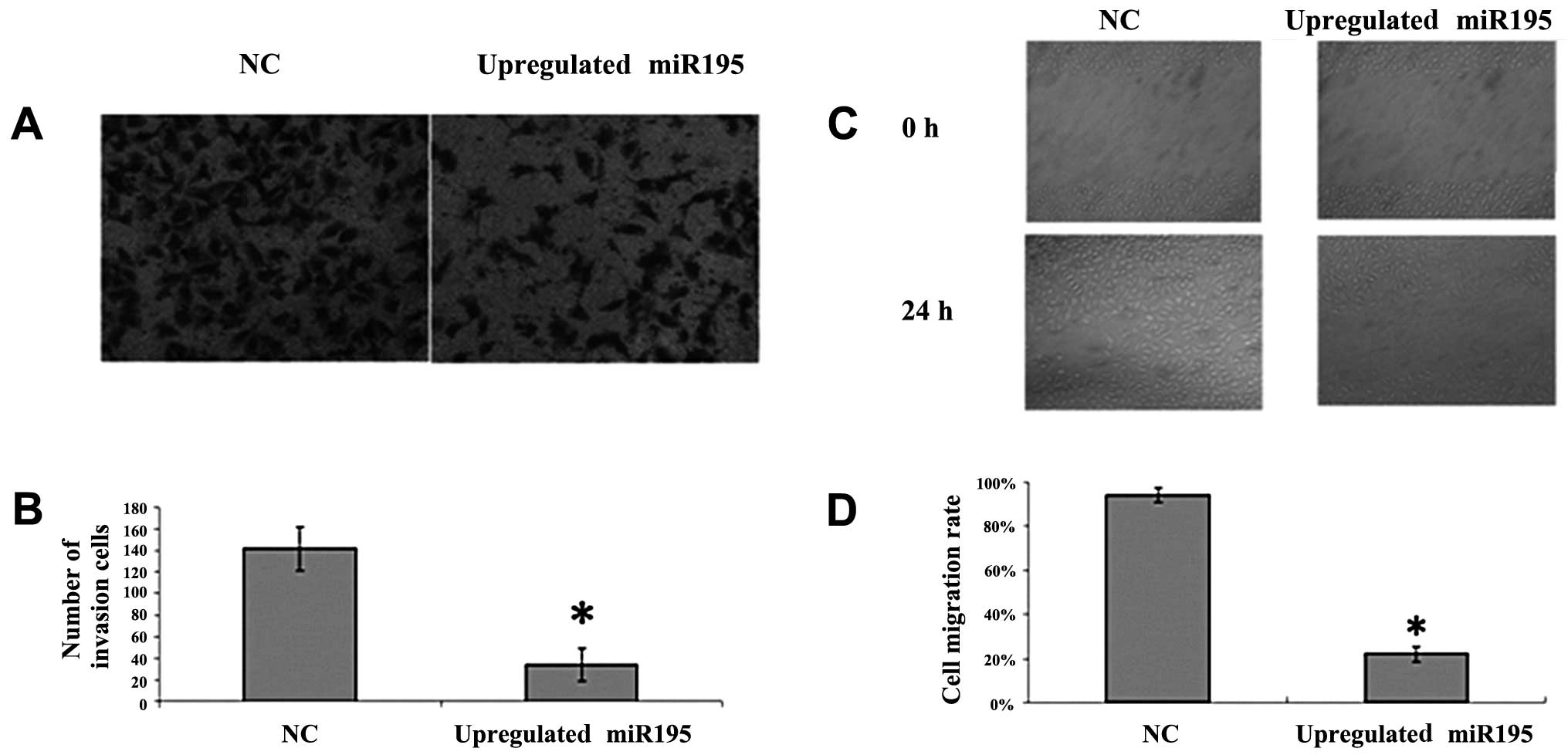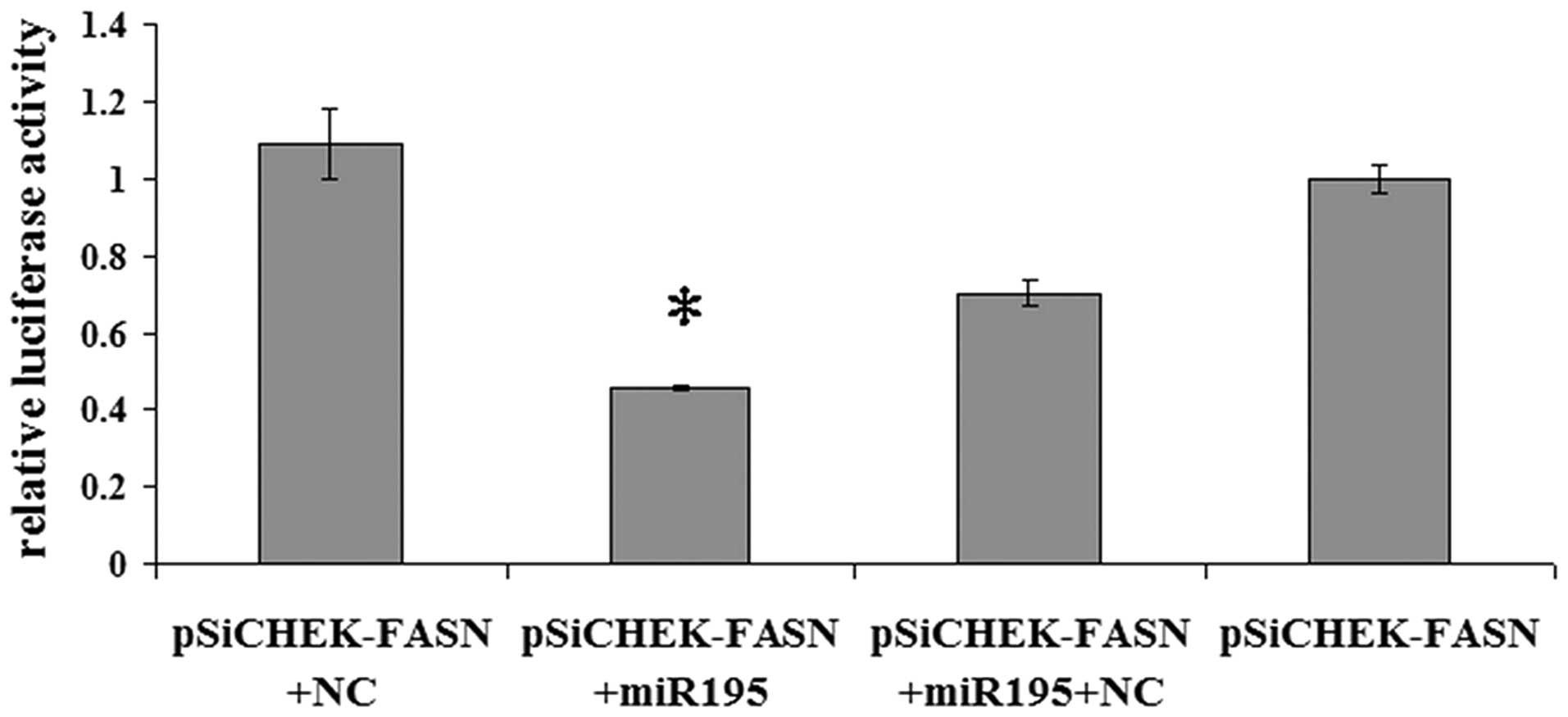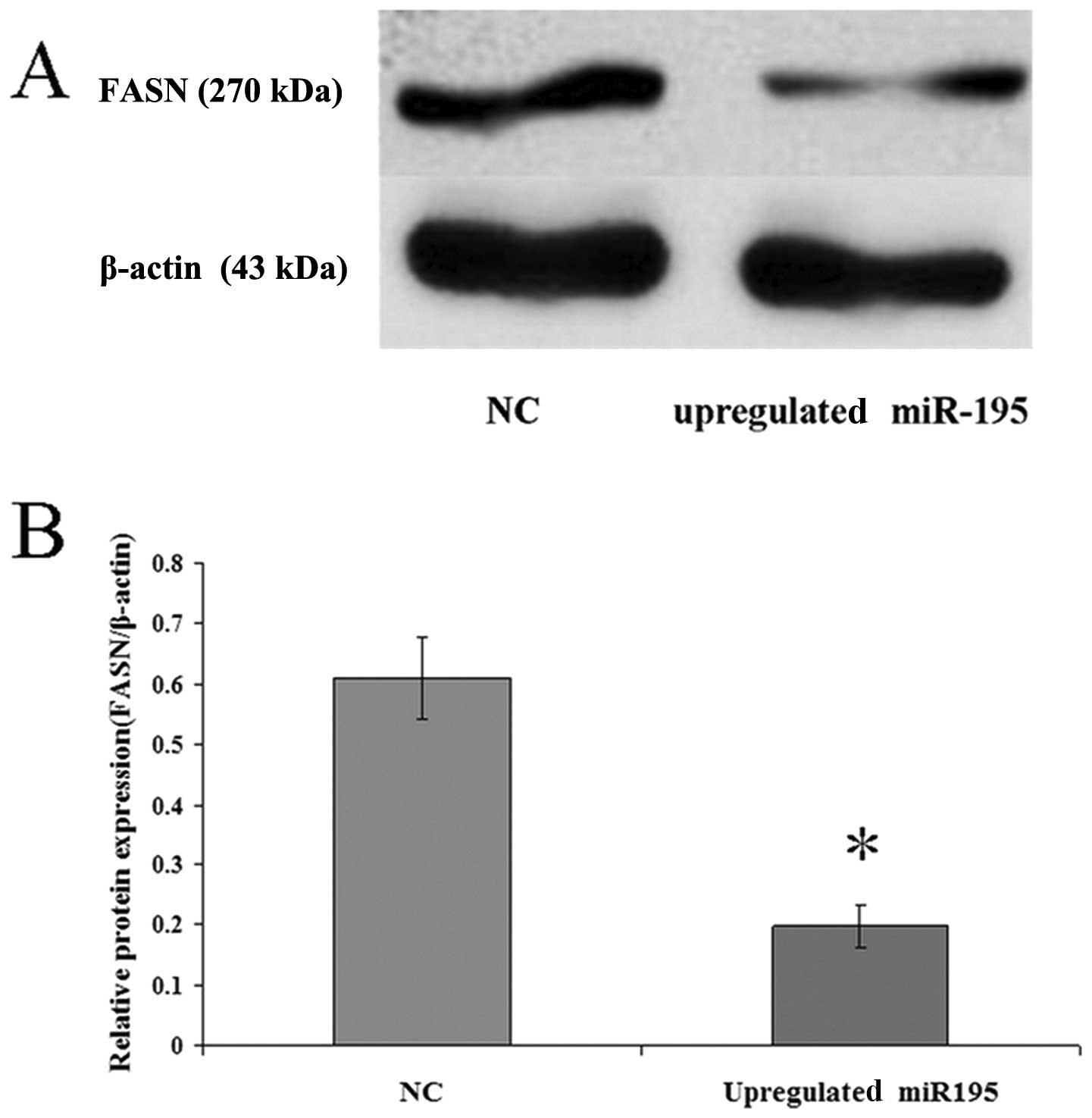microRNA-195 suppresses osteosarcoma cell invasion and migration in vitro by targeting FASN
- Authors:
- Published online on: August 16, 2012 https://doi.org/10.3892/ol.2012.863
- Pages: 1125-1129
Abstract
Introduction
Osteosarcoma (OS) is the most common primary malignant neoplasm in adolescents. The estimated worldwide incidence rate is 4 million per year, with a peak incidence at the age of 15–19 years (1). By combining surgery with multiagent chemotherapy, the 5-year cumulative survival rate of primary OS has significantly improved to 60–90% in the past three decades (2–6). Unfortunately, as a result of approximately 80% of patients eventually developing metastatic disease following surgical treatment (7), pulmonary metastasis in OS patients is a major cause of fatal outcome (8). Therefore, it is essential to determine the mechanisms contributing to invasion and metastasis in OS.
Fatty acid metabolic pathways play an important role in carcinogenesis (9). Fatty acid synthase (FASN) is an enzyme crucial to endogenous lipogenesis in mammals and is responsible for catalyzing the synthesis of long-chain fatty acids. FASN is critical in sustaining the biological features of cancer cells (10). FASN is expressed at high levels in a variety of human tumors (11–14), but exists at low levels in normal tissues. Various studies have reported that the inhibition of FASN expression suppresses cancer cell proliferation in vitro and in vivo (15–20). Thus, FASN is considered a novel promising target for anticancer therapy. Recent studies (21,22) have revealed that FASN may also contribute to cancer cell metastasis.
microRNAs (miRNAs) are endogenous small RNAs averaging 20 to 24 nucleotides, transcribed from non-protein-coding genes or introns, which mediate translational suppression or cleavage of their target mRNAs by binding to complementary sites in their 3′-UTR (23–25). A large number of miRNAs are located inside or close to chromosomal fragile sites that are frequently lost or amplified in cancers (26). miRNAs have been characterized as oncogenes, tumor suppressors or as components of regulatory pathways critical for tumorigenesis, therefore miRNAs play an important role in tumorigenesis and metastasis.
Recently, miR-195 has been reported to be deregulated in certain types of cancer, including upregulation in chronic lymphocytic leukemia and breast cancer but downregulation in hepatocellular carcinoma, adrenocortical carcinoma, and squamous cell carcinoma of the tongue (27–31). miR-195 was also suggested to be correlated with lymph node metastasis and poor prognosis in colorectal cancer (27). However, the role of miR-195 in OS migration remains elusive. In our previous study, the prediction was performed by microRNA.org and TargetScan.human6.0. The results revealed that FASN may be a target of miR-195. Therefore, we speculate that miR-195 may suppress OS invasion and metastasis by targeting FASN.
In the present study, we found that miR-195 functions as a tumor suppressor in OS, upregulates miR-195 expression in the OS cell line U2OS and reduces cell migration and invasion in vitro. Additionally, it was revealed that FASN may be directly targeted by miR-195. Together, our data indicate that miR-195 plays an important role in regulating OS cell metastasis by targeting FASN.
Materials and methods
Cell culture and transfection
The human OS cell line U2OS (Shanghai Cell Bank, Chinese Academy of Sciences) was cultured in Dulbecco’s modified Eagle’s medium (DMEM) with 10% fetal bovine serum (FBS) and incubated at 37˚C in 5% CO2. U2OS cells were seeded in six-well plates at 30% confluence one day prior to transfection. Transfection with miR-195 or negative miRNA was performed using Lipofectamine 2000 reagent (Invitrogen, Carlsbad, CA, USA). Transfection complexes were prepared according to the manufacturer’s instructions.
Quantitative real-time PCR (qRT-PCR)
Total RNA from cells treated with miR-195 or the negative control miRNA was isolated using a TRIzol reagent (Tiangen, Beijing, China) and reverse transcribed using a reverse transcription kit (Tiangen) according to the manufacturer’s instructions. Reactions were performed and analyzed using an ABI 7300 system (Applied Biosystems, Carlsbad, CA, USA). β-actin was used as the internal control to quantify initial cellular transcripts. Details of the primers and probes used in this study are summarized in Table I. All qRT-PCR were performed six times according to the manufacturer’s instructions. The relative expression level of FASN was normalized to that of β-actin by the 2−ΔΔCt cycle threshold method. The ΔCt data were collected automatically. The average ΔCt of each group was calculated by the following formula: ΔCt = average miR-195 Ct - average of β-actin Ct. ΔΔCt was calculated by ΔΔCt = ΔCt of miR-195 group - ΔCt of the negative control group. The fold-change in FASN expression level was calculated using 2−ΔΔCt.
Luciferase activity assay
Primers were designed in accordance with the Genbank query FASN gene mRNA (NM_004104.4) sequence. A fragment of the 3′-UTR of FASN was amplified from U2OS cells by PCR using the forward primer 5′-CCCCTCGAGCCTGCCACCGGAGGTCACT-3′ and the reverse primer 5′-CGGGCGGCCGCGTGGGAG GCTGAGAGCAGCA-3′. Following digestion of the PCR product by XhoI and NotI, the FASN 3′-UTR was cloned into pSiCHECK2 (Promega, Madison, WI, USA) at the XhoI and NotI sites. All PCR products were verified by DNA sequencing. U2OS cells were cotransfected with the pSiCHECK2 vectors containing the 3′-UTR variants and miR-195 or the negative control miRNA. Luciferase activity was measured 36 h after transfection. The firefly luciferase activity was then normalized to the Renilla luciferase activity.
Transwell invasion assay in vitro
Invasion assays were performed in triplicate using Transwell invasion chambers (Costar 3422, Corning Inc., NY, USA) coated with Matrigel (50 μl per filter) (BD, USA) as described in the manufacturer’s instructions. U2OS cells were transfected with either miR-195 or the negative control oligonucleotide, cultured for 48 h and then transferred to the top of the Matrigel-coated invasion chambers in 1% fetal calf serum DMEM/F12 (2x104 cells/well). DMEM/F12 containing 10% fetal calf serum was added to the lower chambers. Following incubation for 24 h, cells that remained on the top of the filter were removed and cells that migrated to the lower surface were fixed in 90% alcohol followed by crystal violet staining. The values for invasion were obtained by counting three fields per membrane and represented as the average of six independent experiments made over multiple days.
Wound healing migration assay
When U2OS cells transfected with miR-195 or negative control oligonucleotides were grown to confluence, a scratch in the cell monolayer was made with a micropipette tip. Following incubation of the cells under standard conditions for 24 h, the plates were washed twice with fresh medium and images were captured at different times. The migration potential was estimated by counting the cells that migrated from the wound edge. The cell migration rate was obtained by counting three fields per area and represented as the average of six independent experiments made over multiple days.
Western blot analysis
U2OS cells in the exponential growth phase were transfected with miR-195 for 48 h. Total proteins were isolated from U2OS cells. Protein concentrations were measured using a Micro BCA protein assay kit (Pierce, Rockford, IL, USA). Proteins were resolved by 10% SDS-PAGE gel, transferred to the nitrocellulose membrane and blocked in 5% non-fat dry milk in Tris-buffered saline pH 7.4, containing 0.05% Tween-20. They were subsequently blotted with a rabbit polyclonal antibody against FASN (1:1000, Santa Cruz Biotechnology Inc., Santa Cruz, CA, USA) and goat anti-rabbit IgG (1:3000, Santa Cruz), with β-actin used as a loading control. Signals were detected by secondary antibodies labeled with horseradish peroxidase (HRP). All western blot analyses were performed six times.
Statistical analysis
Data were expressed as the means ± SD of at least three experiments. A one-way analysis of variance (ANOVA) test and a least significant difference (LSD) test were used for statistical analysis. A value of p<0.05 was considered to indicate a statistically significant result. All analyses were performed using SPSS version 13.0 (Statistical Package for the Social Sciences, Chicago, IL, USA).
Results
miR-195 inhibits cell invasion and migration in vitro
To further investigate the effect of miR-195 on U2OS cell invasion and migration, we employed the Transwell invasion assay and wound healing assay. U2OS cells were transfected with miR-195 or negative miRNA. We observed a significant inhibition of invasion into Matrigel in miR-195-transfected cells (Fig. 1A and B; P<0.05). We also noted that the number of migrated cells transfected with miR-195 was significantly fewer than the number transfected with negative miRNA (Fig. 2C and D; P<0.05). These results suggest that the upregulation of miR-195 inhibits the invasion and migration of U2OS cells.
FASN is a direct target of miR-195
To validate whether miR-195 regulates FASN directly through a putative binding site in U2OS cells, we cloned FASN 3′-UTR in the predicted miRNA binding site into the luciferase gene (pSiCHECK2; Promega). Following cotransfection with the pSiCHECK2 vectors and miR-195 or the negative control miRNA, the upregulation of miR-195 in U2OS cells transfected with miR-195 resulted in a significant decrease in the luciferase activity of the wild-type FASN 3′-UTR (Fig. 2; P<0.05). The results indicate that FASN is a direct target of miR-195.
miR-195 negatively regulates FASN expression in U2OS cells
To investigate the correlation between miR-195 and FASN, miR-195 was upregulated in U2OS cells by treatment with miR-195 for 36 h. The expression levels of FASN mRNA and protein were measured by qRT-PCR and western blot analysis. The data (2−ΔΔCt = 0.162±0.01179) revealed that the FASN mRNA expression in cells transfected with the negative control vector was six-fold higher than the expression in the cells transfected with miR-195. Western blot analysis revealed that upregulated miR-195 in cells leads to a corresponding decrease in endogenous FASN protein (Fig. 3). These data suggest that miR-195 may negatively regulate FASN expression.
Discussion
miR-195, one of the miR-16/15/195/424/497 family members, has been shown to play an important role in tumorigenesis. Recently, miR-195 has been reported to be downregulated in hepatocellular carcinoma, adrenocortical carcinoma and squamous cell carcinoma of the tongue (29–34). However, in chronic lymphocytic leukemia and breast cancer, miR-195 expression is reported to be upregulated (35–39). Hence, the deregulation of miR-195 may be different in different types of cancer, and the role of miR-195 in carcinogenesis and progression cannot simply be concluded to be that of a tumor suppressor or an oncogene. The roles of miR-195 deregulation in cancer development remain to be further investigated. In the present study, we found that miR-195 is downregulated in the human OS cell line U2OS. The inhibition of migration and invasion due to the upregulation of miR-195 in the human OS cell line U2OS was also observed. This suggests that miR-195 functions as a tumor suppressor and inhibits U2OS cell migration and invasion, which is consistent with its roles in gastric cancer, colorectal cancer and hepatocellular carcinoma (27,29,40).
Our previous study reported that the inhibition of FASN causes a decrease in OS cell invasion and migration. The prediction of the FASN gene was performed using Targetscan software (microRNA.org and TargetScan.human6.0). This revealed that miR-195 may be targeting FASN. In the present study, RT-PCR and western blotting were performed to investigate the molecular mechanisms that inhibit the migration and invasion by restoring miR-195 in U2OS and to detect the expression levels of FASN mRNA and protein in U2OS cells. The results revealed that FASN expression was significantly inhibited in cells transfected with miR-195 when compared with the control group (Fig. 3). This suggests that the restoration of miR-195 expression may inhibit FASN expression in U2OS cells. Furthermore, to identify whether miR-195 can genuinely regulate the expression of FASN, the FASN 3′-UTR was cloned into the pSiCHECK2, placing the 3′-UTR with the majority of potential miRNA binding sites downstream of the coding sequence of luciferase (pMiR-Report; Promega). U2OS cells were cotransfected with the pSiCHECK2 vector containing the 3′-UTR and miR-195 or negative miRNA. We found that the overexpression of miR-195 significantly reduced the luciferase activity from the reporter construct containing the FASN 3′-UTR. This indicates that FASN is a direct miR-195 target. However, as there were hundreds of predicted targets of miR-195 revealed in the TargetScan prediction and a single miRNA has been proven to target multiple mRNAs in order to regulate gene expression (41), it is probable that other targets of miR-195 may also participate in OS migration and invasion and miR-195 may also target different molecules in different types of cancer. Additionally, the tumor microenvironment may influence tumor progression, invasion and migration. Therefore, further studies are needed to identify the entire role of miR-195 in OS metastasis.
Our present study indicated that the expression of the oncogene FASN is negatively regulated by miR-195 through a special binding site in the FASN 3′-UTR. Moreover, miR-195 inhibits cell invasion and migration in U2OS cells. These results suggest that miR-195 may serve as a target in the discovery of effective therapies for OS.












